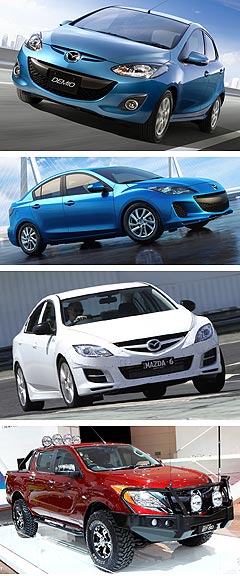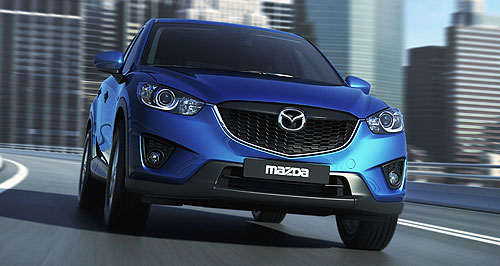Future models - Mazda - Mazda6Mazda’s Sky has its limitsBlue Sky: The all-new Mazda CX-5 compact SUV will be the company's first model to use a full range of SkyActiv technologies when it arrives here next year. Ground-breaking SkyActiv chassis tech may not underpin Mazda223 Aug 2011 AUSTRALIA’S first taste of Mazda’s break-through SkyActiv engine technology will come in the form of the facelifted, 2.0-litre SkyActiv-G petrol-engined Mazda3 SP20 in October, before the company’s first 100 per cent Sky model – the all-new CX-5 compact SUV – arrives here next year, but Mazda’s entire passenger car range will not become an all-Sky affair until 2017 at the earliest. After the 2012 CX-5, the next model to combine Mazda’s lighter and more rigid new SkyActiv chassis with a full range of SkyActiv petrol and diesel engines – and the brand’s fresh Kodo design language – will be the redesigned Mazda6 mid-sizer, which should appear late next year before going on sale in Australia in 2013. The all-new Mazda3 should follow suit the following year by incorporating the full complement of SkyActiv technologies, but Mazda Australia managing director Doug Dickson said on the eve of a CX-5 prototype drive in Iceland this week – details of which are embargoed until August 31 – that a SkyActiv version of the Mazda2 was not on his company’s radar for the foreseeable future. Mazda recently launched its first Sky-equipped model in Japan, a Mazda2 (Demio) fitted with a 1.3-litre SkyActiv-G direct-injection four-cylinder petrol engine with idle-stop, but Mr Dickson said there was “no indication that the version would be made available to us”.  From top: Mazda2, Mazda3, Mazda6 SkyActiv test mule, Mazda BT-50. From top: Mazda2, Mazda3, Mazda6 SkyActiv test mule, Mazda BT-50.Further, because the current Mazda2 – based on a platform that was co-developed with former majority shareholder Ford and also underpins that company’s Fiesta – was launched four years ago, Mr Dickson said the next-generation Mazda2, which is due to emerge next year with an all-new body but the same basic platform, would not be the recipient of a SkyActiv chassis. “The Mazda2 was only launched in 2007, so because the (model) cycle plan is to do a new ‘top hat’ (bodyshell) every five years the Two platform won’t change immediately,” Mr Dickson said. The next all-new Mazda2 is not due until around 2017, but even then there is no guarantee it will be based on SkyActiv chassis technology. “Mazda has not ruled out further joint projects (with Ford) irrespective of the ownership arrangement,” said Mr Dickson. “There’s still an awful lot of cross-pollination between the two companies and the (next) Two could still be shared if it makes sense. They’ve certainly not ruled that out for the next generation.” The next all-new Mazda – the redesigned BT-50 utility range based on the same Australian-designed and engineered T6 platform that will underpin Ford’s next Ranger ute from September – is due on sale in October and will feature an all-new ladder chassis and (non-Sky) diesel engines. In the same month, Mazda Australia will release its first Sky-equipped model, the new SP20, that will be the headline variant in a facelifted Mazda3 range, powered by a high-compression direct-injection 2.0-litre SkyActiv-G petrol four, matched with the choice of six-speed SkyActivmanual or automatic transmissions incorporating a fuel-saving idle-stop function. However, while the all-new Mazda6 and Mazda3 will come with the full suite of SkyActiv engine and chassis technologies in 2013 and 2014 respectively, Mr Dickson indicated Mazda could fulfil its commitment to reduce the fuel consumption of its global model range by 30 per cent between 2008 and 2015 without applying the full (and more expensive) Sky treatment to its smallest model, the B-segment Mazda2 light-car. “The difficulty with B (light) cars is that customers don’t see B and C (small) cars as different,” he said. “They see small cars, some of which are more expensive than others. So it’s hard to make an expensive small car (financially viable). “We don’t necessarily need anything special to promote the Two. It’s well respected and its fuel consumption is good. Does the extra cost of Sky technology make financial sense? Probably not.” Mr Dickson said that despite a bevy of all-new light-cars due this year, the rollout of Sky technologies in Australia’s Mazda2 would be “a more gradual process” than that of the all-new CX-5 and would likely echo the “soft launch” of power in this year’s upgraded Mazda3 SP20. He said the more efficient new BT-50 and the Sky-engined Mazda3 – as well as the next all-Sky versions of the Mazda6 mid-sizer and Australia’s top-selling small car – would play a significant role in reducing Mazda’s fleet average fuel consumption, particularly in Australia. “We’ve done the calculations and diesel will help, the new BT-50 will help a lot and, quite clearly, the majority of the savings will come from the Three.” Mr Dickson confirmed the next all-Sky models would be the Mazda6 and Mazda3, but said the midlife makeover – and new SP20 model – from October would be sufficient for the Maada3 to battle stiff new small-car competition including all-new Ford Focus and Holden Cruze hatch models this year and a new Corolla range next year. “We’re not in a great hurry to upset a successful model,” he said.  Read more8th of August 2011  Mazda3 makeover one step closerProduction of facelifted, Sky powertrain-equipped Mazda3 commences in Japan2nd of August 2011  Frankfurt show: All-new Mazda CX-5 unmaskedCX-5 stays true to Minagi SUV concept as Mazda shows its first all-SkyActiv model5th of July 2011  Super-frugal Mazda baby bypassed for OzSkyActiv-equipped 1.3-litre Mazda2 light car is for Japan only - for nowMazda6 pricing
Motor industry news |
Click to shareMazda modelsResearch Mazda Mazda6 pricing
Motor industry news |















Facebook Twitter Instagram